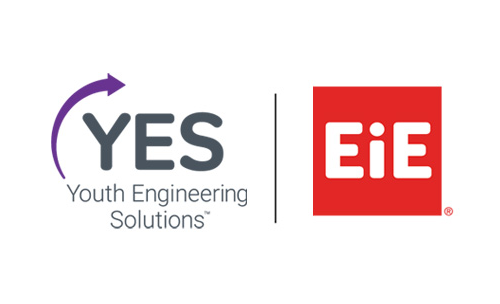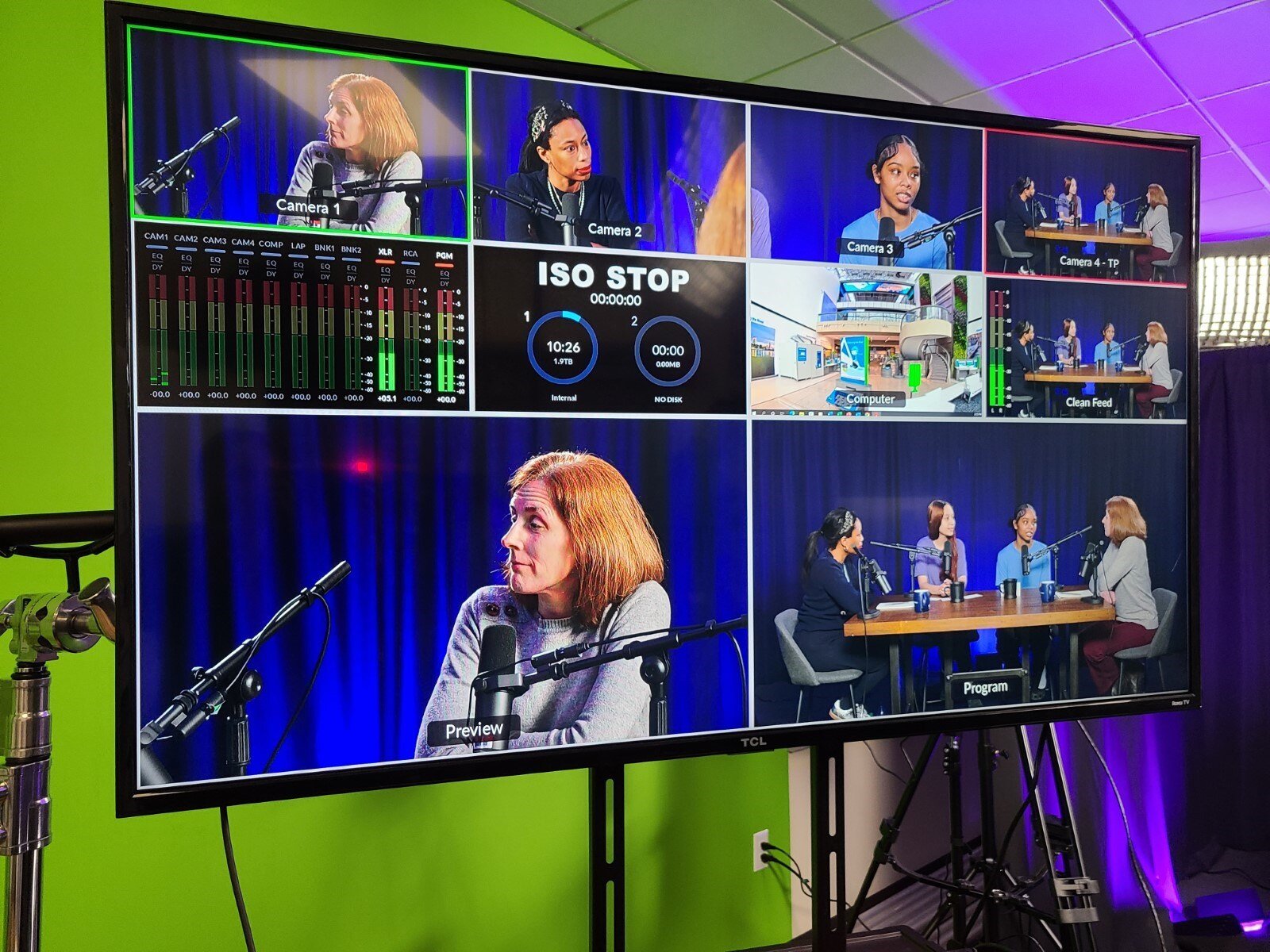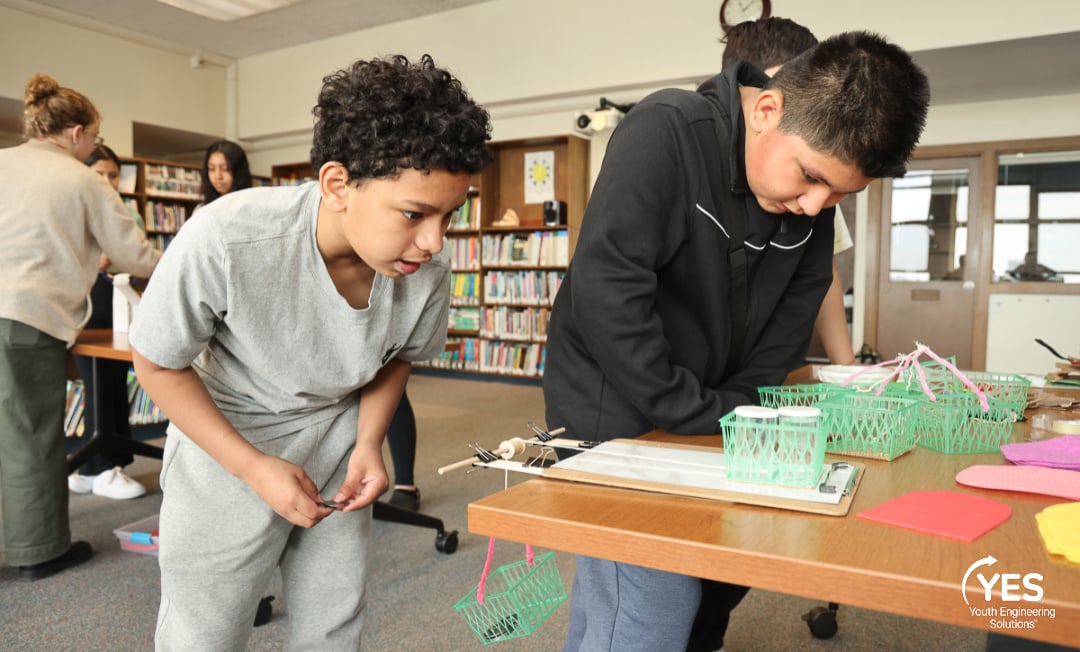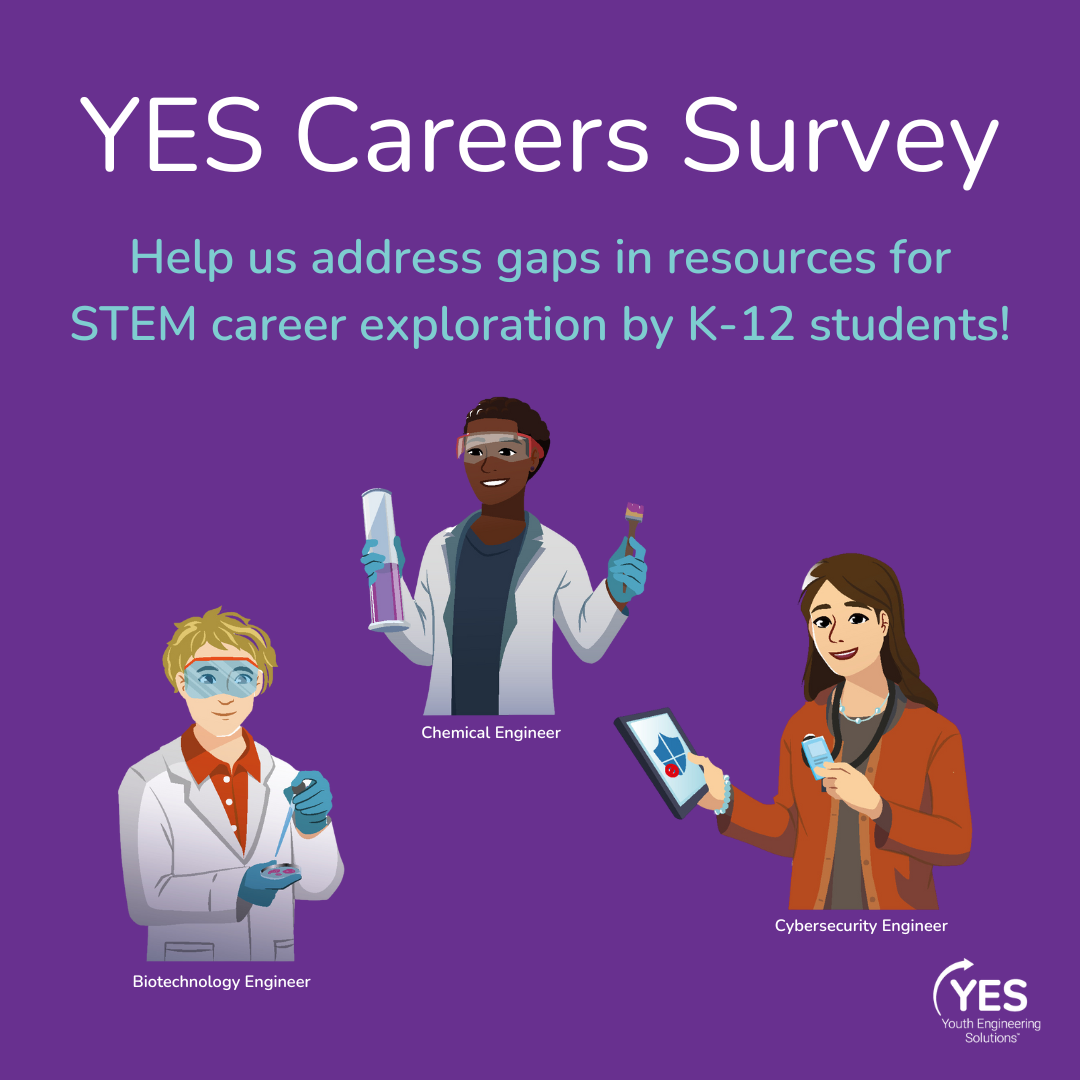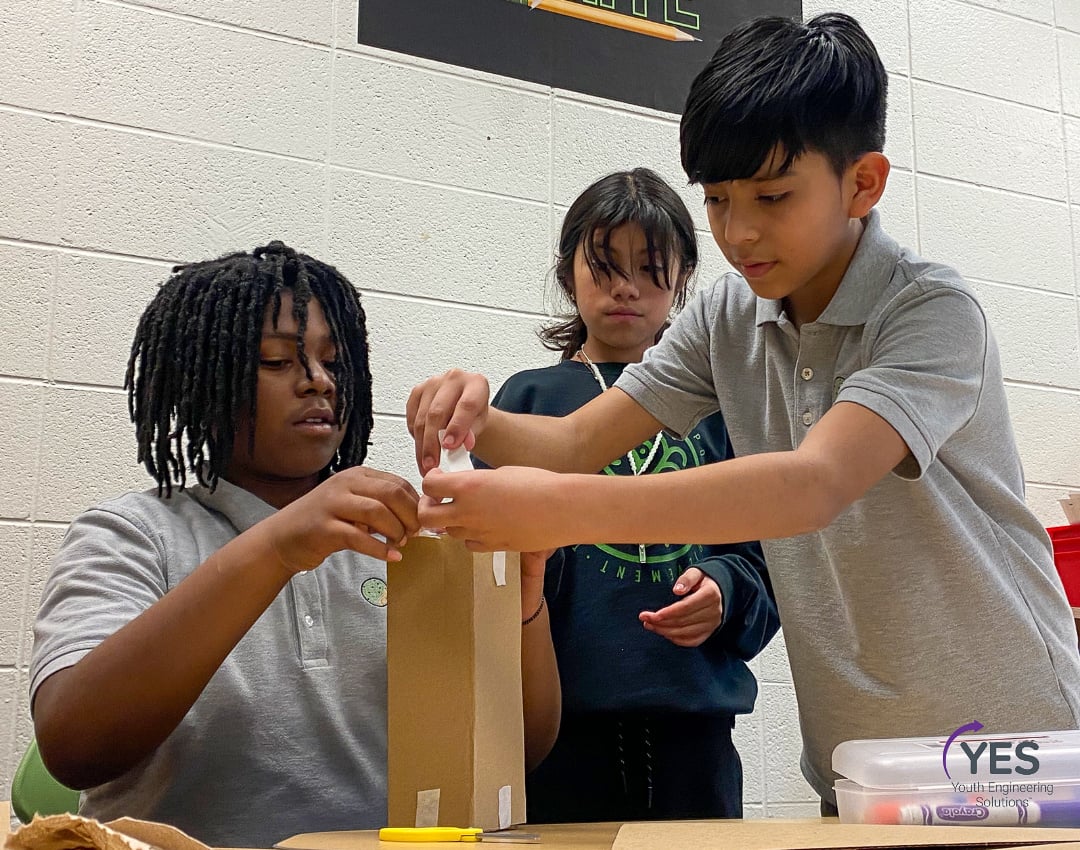Afterschool STEM enrichment designed initially for multilingual learners has benefits for all students.

Students test their designs from the Engineering Rescue Shuttles unit. Credit: YES Staff.
Multilingual learners (MLLs) are one of the fastest growing populations in elementary schools. Although their backgrounds, experiences, and ideas represent a wealth of perspectives that can contribute to learning in and out of class, MLLs remain underrepresented in STEM fields. These youth can also face barriers to both learning and participation, creating a ripple effect of consequences for students and society. Using high-quality STEM materials can close the learning and career gap by providing MLLs with opportunities to participate in class as well as develop vital skills and an interest in STEM fields. Engaging with engineering benefits both MLLs and non MLL students.
YES Enrichment, our latest suite of STEM curriculum for enrichment settings including before-, during-, and after school programming, was designed specifically with MLLs and out-of-school learning in mind. The rationale was informed by the knowledge that:
- MLL students are often pulled out of general education classes during the school day to receive language instruction and support. As detailed in a 2018 National Academies of Sciences Engineering and Medicine report, those missed classes were usually science-related, resulting in a lack of access to a complete STEM education for MLL students.
- Out-of-school programs play a vital role nationwide in providing learning opportunities to activate and/or sustain youths’ STEM knowledge, interests, and identities.[1]
- If we could design a curriculum inclusive and engaging enough that even MLLs could fully participate, we could help spark interest in STEM amongst an underrepresented and fast-growing segment of our population, while also producing materials that benefit all students.
Incorporating engineering education into afterschool programs and summer camps is a tool that could help increase youth language development and STEM exposure and interest. With spring break and summer just around the corner, YES Enrichment curriculum can optimize these settings for transformative learning and development for all students.
The Benefits of Engineering Education

Engineering education is truly a one-stop shop for learning. By its nature, engineering builds in students learning language and educational subject matter in a way that’s engaging, hands-on, and complementary to their existing general education. As a discipline, engineering offers specific benefits crucial to student learning. These benefits (such as multimodal learning, teamwork, materiality, learning from failure, etc.) are inherent to engineering and engineering education and support learning for MLLs in informal settings. Engineering education also allows MLLs to stand on more equal footing with their peers: the discipline tends to be new to all students, and it encourages participant creativity (independent of language).
With the generous support of a grant from the National Science Foundation, Youth Engineering Solutions (YES) developed the research-backed “Model for Equity-Oriented Engineering Learning.” The model’s premise was youth would participate in socially engaged engineering relevant to their lives, community, and world. That approach established the foundation supporting the benefits at the heart of YES Enrichment. We co-developed the model with educators, then tested and refined it with the help of teachers and students from across the country. Then we applied the model to the YES Enrichment curriculum, whose unit materials are now available to download for free for upper and lower elementary levels. Each unit consists of five core open-ended activities and four optional ones and includes tips for language development.

The “LD” or “Language Development” icons on the right side feature language scaffolding tips. These tips are found throughout the YES Enrichment Educator Guides to support educators implementing the curricula.
We both draw from published research to develop our materials, and we conduct our own scholarly research. We became intrigued by the possibilities for engineering with students who were learning English through comments shared by a number of teachers. This led us to start to collect data about the benefits of engineering with MLLs. The chart below, lists some of the benefits we observed in classrooms and that educators described in surveys and interviews[1]. These benefits resulted in other effects in students, including empathy, as well as subject matter and communal connection. As Cheryl, an afterschool teacher from Tom’s River, NJ, noted: “Sometimes we think of engineering and science as cold and just not caring, it’s black and white. But I saw a lot of compassion coming out of my children. And that really was heartwarming. It was really nice to see them thinking outside their zone and saying ‘Well, if this really happened, we could do this.”

A modified table of the benefits of engineering that engage MLLs. Credit: C. Cunningham et al via the research journal, Science Education.
A few of the benefits are worth highlighting for their value not just to MLLs, but all students.
Concurrent Learning
When students are motivated to communicate, they’re more likely to do so. Our engineering design challenges are anchored in real-world problems, providing students ample motivation to communicate and connect. For MLLs, the hands-on nature of the challenges encourages multiple ways of learning language and understanding the activities. For non-MLL students, such as those who may be more introverted or shy, experiences like testing designs and using materials offer compelling avenues to communication because they have something tangible they’ve connected with to discuss.

An example of vocabulary glossary materials in the Rescue Shuttles unit, part of the YES Enrichment curriculum.
Each design challenge is structured to build from and expand student knowledge. YES curricula do this through the use of language scaffolds and vocabulary, along with other resources. Design challenges allow students to lead with a hands-on experience and then to learn the associated vocabulary. They process language and internalize definitions while using technical words (like “opaque” or “constraint”) that identifies their actions or describes things related to the activities. This immersion encourages building on students’ language and experiences, while simultaneously building their confidence in language, learning, and engineering.
Gina, an afterschool educator from Chelsea, MA, described how this played out during her afterschool sessions: “I noticed all my students (all MLLs) testing, describing failures, and using phrases like ‘I need to change _____ about my sock aid because_____,’ and then making the changes. They were able to fully describe their ‘failures’ and next steps for improvements. I overheard several MLL students using frames like ‘What if you tried ____ to _____,’ which are sentence frames from previous lessons, too.”
Contextualized Settings for Design Challenges

Snippets of a comic from the Engineering Sock Assistive Devices unit that detail a design challenge.
The real-world problems posed in the units offer MLL students the opportunity to tap into their lives and experience and connect with the challenges. They’re able to bring their prior science knowledge to the activities regardless of the language they learned it in, while using multimodal communication to express themselves.
Priscilla, an educator from Anthony, TX, noticed how her students were able to connect with the situations presented in the Engineering Rescue Shuttles and Engineering Sock Assistive Devices units. “For the flooding part [in Rescue Shuttles], they were able to talk about times when their house flooded... One of them talked about the refrigerator that came out, that flooded their house and how all their stuff was wet,” she said. “Then for the [Sock Assistive Devices], there was one of the kids, his dad's hand got blown up. He's a soldier. And he talked about how he uses [a] different [device], like a hook… And so they made those connections and talked about like their own experiences, which I thought was really cool.”
Multimodal Communication

YES Enrichment units use various resources, such as comics, to connect students with language, signs, and symbols of the design challenges. Credit: YES Staff.
Engineering invites students to communicate in a variety of ways. For MLL students, the ability to express themselves through non-verbal communication (i.e., drawing or gesturing) means they can still contribute meaningfully to discussions even when their developing verbal English language skills may hinder the verbal or written communication. This kind of participation lets MLL students learn academic content as they are learning the language.
Said Jacqueline, an afterschool educator from Chelsea, MA, “Students were given the opportunity to use many forms of communication which allowed them to be comfortable in how they chose to communicate. If a student started out by drawing and making gestures, by the end they were already using sentences (even if imperfect) in English. It’s a great way to scaffold.”
Shelly, an afterschool educator from Lebanon, PA, noticed the transformation that took place with her MLL students once they began to engineer. “[The] MLL students, English learners, [were] very shy and just very reserved—until they were building. We were launching and they were seeing the success that they were able to have. So yes, definitely could see the engagement and just how proud they were.”
Teamwork

Students work together to complete a task from a YES Enrichment introduction activity. Credit: YES Staff.
Engineering is usually a team-based, collaboration-heavy endeavor, anchored by the tenet that a team’s many ideas ultimately strengthens it. Alongside that, engineering encourages communication to narrow focus to a select few ideas. Having a common goal—creating the best design to complete the challenge—incentivizes students to communicate and compromise, to work together in order to accomplish the task at hand. The result is an environment ripe for collaboration and communication, regardless of imperfections.
Michelle, an afterschool educator in Lebanon, PA, witnessed the collaborative and supportive atmosphere firsthand. “The students loved the opportunity to collaborate with each other,” she said. “At first, they were really hesitant to get in there and start building their designs. But the opportunity that the program gave for other students to kind of bounce ideas off of one another—I feel like this is super helpful for students. And then when we got to the part where they could test their sock aids, they weren't successful the first time around. But they really encouraged each other to keep trying - gave each other different ideas...”
Elevating Afterschool Learning with YES Enrichment

The impact of YES Enrichment shows that engineering education offers key opportunities for student language learning, STEM subject matter exposure, and vital skills. At the same time, it provides pathways for students who benefit from additional language scaffolds to participate meaningfully in activities and connect with the peers. Because out-of-school programs represent an additional opportunity to engage youth in learning, engineering education is an efficient way to create positive attitudes towards STEM, increase their STEM career knowledge, improve their critical thinking and communication skills, and more. YES Enrichment exposes students to vital benefits such as concurrent learning, contextualized settings, multimodal communication, and teamwork—benefits that are useful beyond MLLs, they're invaluable for all students.
This article is based upon work supported in part by the National Science Foundation Broadening Participation in Research (BPE) Grant #205434. Any opinions, findings, and conclusions or recommendations expressed in this material are those of the authors and do not necessarily reflect the views of the National Science Foundation.
[1] Cunningham, C., Kelly, G. J., & Meyer, N. (2021). Affordances of engineering with English learners. Science Education, 105(2), 255-280.
***
Bring YES Enrichment into your afterschool program or summer camp by downloading our free educator guides. Then, make preparation easy by purchasing pre-made materials kits.
New to teaching STEM or want to brush up on your engineering education teaching skills? Come to one of our Professional Learning events!
